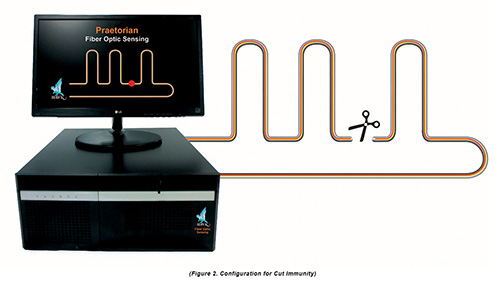Setting Up a Fiber Optics Infrastructure for Security Installations in Commercial Spaces
Setting Up a Fiber Optics Infrastructure for Security Installations in Commercial Spaces
Blog Article
The Ultimate Guide to Fiber Optic Safety And Security Solutions for Your Business
In a period where protection issues are critical for businesses, understanding the complexities of fiber optic technology can be transformative. This overview lays out exactly how incorporating fiber optic protection systems not only improves data security but additionally supplies benefits like resistance to disturbance and real-time surveillance abilities.
Recognizing Fiber Optic Innovation

The core of a fiber optic cable television is composed of a thin glass or plastic facility, bordered by a cladding layer that shows light back right into the core. Single-mode fibers are created for long-distance transmission, while multi-mode fibers are suitable for shorter ranges, commonly used within buildings.
Optical fiber are not only much faster however additionally much more protected than standard circuitry. Their fundamental resistance to electromagnetic interference and the difficulty of taking advantage of the signal without discovery make them a preferred option for companies focusing on information integrity and safety. As organizations significantly rely upon secure and reliable interaction systems, comprehending fiber optic innovation becomes crucial for informed decision-making.
Key Benefits of Fiber Optic Safety And Security
When taking into consideration safety and security alternatives for a service, the benefits of fiber optic systems are especially engaging. Fiber optic technology offers extraordinary information transmission speeds and data transfer capability, making it suitable for managing high-resolution video feeds from security cams. This ability ensures that security employees obtain real-time data, enhancing total feedback times to potential security hazards.
Furthermore, fiber optic cords are naturally immune to electromagnetic interference, which can compromise the integrity of conventional copper-based systems. This resistance guarantees that the data sent stays protected and uninterrupted, supplying an extra reliable safety and security framework. In addition, fiber optics are less at risk to physical damages, as they are made from glass instead of metal, minimizing upkeep prices and downtime.
Another substantial advantage is the enhanced scalability of fiber optic systems. As service demands develop, fiber networks can be conveniently increased to suit added security gadgets without significant overhauls to the existing infrastructure. Fiber optic systems use boosted cybersecurity functions, including file encryption capabilities that safeguard sensitive information from unauthorized access. Jointly, these benefits make fiber optic safety and security systems a durable choice for businesses looking for to boost their safety procedures.
Installation Process and Factors To Consider
Taking into consideration the complexities included, the installation process of fiber optic protection systems calls for cautious preparation and implementation. The initial action involves an extensive site evaluation to determine ideal areas for cabling and devices. This analysis must take into consideration environmental variables, existing infrastructure, and potential susceptabilities.

In addition, the installation has to comply with regional building regulations and market standards. This may include collaborating with various stakeholders such as building supervisors, IT groups, and security employees to make certain seamless integration with existing systems.
Post-installation, rigorous screening is essential to confirm system efficiency and determine any kind of problems that may arise. By prioritizing these factors to consider during the installation process, businesses can guarantee a durable and reliable fiber optic security system that satisfies their details security needs.
Most Current Developments in Fiber Optic Safety And Security
Recent improvements in fiber optic innovation have significantly improved the capabilities of protection systems for services. Among one of the most significant technologies is the combination of fiber optic sensors that can discover vibrations and breaches along the boundary of a center. These sensing units offer real-time surveillance, allowing quick feedback to potential violations.
In addition, the growth of distributed fiber optic noticing modern technology allows for the continual monitoring of big areas with a solitary fiber wire. This method not just decreases installation expenses but also enhances the reliability of keeping an eye on systems by getting rid of the need for numerous, separate sensors.
Moreover, innovations in multiplexing strategies have made it possible for organizations to transfer substantial amounts of information view publisher site over fiber optic networks, enhancing the capacities of video monitoring systems. High-definition video clip feeds can now be sent over fars away without loss of high quality, making sure that safety employees have accessibility to clear and workable info.
Finally, the usage of expert system (AI) together with fiber optic systems is transforming threat detection. AI algorithms can examine information from fiber optic networks to identify uncommon patterns or actions, permitting aggressive safety and security measures. These developments collectively represent a significant leap onward in fiber optic safety and security technology.
Choosing the Right System for Your Service
Selecting the proper fiber optic protection system for your service is vital for making sure optimal security and tranquility of mind. To make an enlightened option, examine your particular safety needs, thinking about factors such as the size of your facilities, the nature of your operations, and potential vulnerabilities.
Begin by evaluating the level of security needed; for instance, risky settings might demand innovative systems with incorporated surveillance and breach discovery abilities. Next, take into consideration scalability; as your service grows, your safety and security system ought to be qualified of increasing to accommodate increased needs without substantial overhauls.
In addition, investigate the reliability and performance of various systems. Seek suppliers with recognized track records and client reviews that vouch for their solution quality. It's likewise advisable to ask about the modern technology's compatibility you could check here with existing facilities, ensuring a seamless assimilation procedure.
Conclusion
In conclusion, fiber optic safety and security systems provide a durable service for enhancing organization protection infrastructures. The most current developments additionally reinforce the effectiveness of these systems, making certain that organizations stay safe and secure and versatile in an ever-evolving hazard landscape.
Report this page